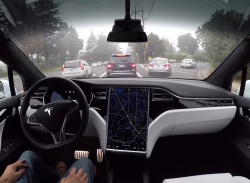
— A Tesla phantom braking class action lawsuit alleges 2021-2022 Tesla Model 3 and Tesla Model Y vehicles suddenly brake even though there are no objects in the road.
The Tesla vehicles are equipped with Autopilot, a feature allegedly rushed to market before the technology was safe.
The Tesla phantom braking lawsuit also alleges the automatic emergency braking (AEB) is defective and was sold to consumers as a safety feature.
Yet the feature meant to save lives allegedly does the opposite by causing Model 3 and Model Y vehicles to suddenly come to complete stops in the roads.
"Essentially, Tesla vehicles are now slamming on brakes in the middle of traffic due to Autopilot. Simply put, as a result of the Defect, the Autopilot and AEB systems at issue here are now a safety hazard rather than a beneficial safety feature." — Tesla phantom braking lawsuit
According to Tesla, automatic emergency braking is designed to "detect objects that the car may impact and applies the brakes accordingly.”
The Tesla Phantom braking lawsuit was filed by North Carolina plaintiffs Michael Costello and Megan Colonel who say their Tesla vehicles braked suddenly.
The plaintiffs assert the Tesla vehicles are too dangerous to operate because drivers cannot control road speeds when there are chances the phantom braking occurs. There are allegedly no normal driving conditions in the Tesla Model 3 and Model Y vehicles when they are at risk of rear-end collisions from the sudden braking.
Tesla's advanced driver assistance system (ADAS) is allegedly much more dangerous than similar features offered by other automakers. According to the phantom braking class action lawsuit, 70% of ADAS-related crashes in the U.S. occur in Tesla vehicles.
The National Highway Traffic Safety Administration has received hundreds of complaints in the last three years from drivers of Tesla vehicles.
NHTSA also opened a formal investigation in February 2022 regarding phantom braking incidents. The investigation includes 2021-2022 Tesla Model 3 and Model Y vehicles, and by May 2022 the government knew of more than 750 unintended sudden braking incidents.
The investigation is ongoing, but the two owners who filed the class action lawsuit contend Tesla knew about phantom braking problems before the vehicles were first sold.
Tesla Phantom Braking Lawsuit: Owner's Manuals
The phantom braking class action references the Model 3 and Model Y owner's manuals which warn customers about automatic emergency braking.
“Several factors can affect the performance of Automatic Emergency Braking, causing either no braking or inappropriate or untimely braking, such as when a vehicle is partially in the path of travel or there is road debris. It is the driver’s responsibility to drive safely and remain in control of the vehicle at all times. Never depend on Automatic Emergency Braking to avoid or reduce the impact of a collision.” — Tesla owner's manual
Although the warning is in the manual, the class action lawsuit says the warning is in small text and "buried" in the middle of the owner's manual.
The warning is also allegedly, "too vague, cursory, and non-specific to adequately warn anyone about the true scope and extent of the dangers of the Sudden Unintended Braking Defect."
The Tesla phantom braking class action lawsuit was filed in the U.S. District Court for the Eastern District of North Carolina (Western Division): Costello, et al., v. Tesla, Inc., et al.
The plaintiffs are represented by Poulin | Willey | Anastopoulo, LLC.




